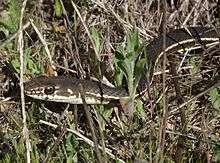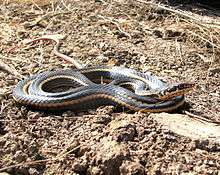California whipsnake
| California whipsnake | |
|---|---|
 | |
| Masticophis lateralis ssp. lateralis | |
| Scientific classification | |
| Kingdom: | Animalia |
| Phylum: | Chordata |
| Class: | Reptilia |
| Order: | Squamata |
| Suborder: | Serpentes |
| Family: | Colubridae |
| Genus: | Masticophis |
| Species: | M. lateralis |
| Binomial name | |
| Masticophis lateralis (Hallowell, 1853) | |
The California whipsnake (Masticophis lateralis), also known as the striped racer, is a colubrid snake found in habitats of the coast, desert, and foothills of California.
Description
M. lateralis is 90–120 centimetres (3.0–3.9 ft) long. It is slender, with two yellowish stripes along its back, set against a dark brown or black back.
California whipsnakes are known to eat a variety of live animals including insects, lizards, snakes, birds, and small mammals.[1][2] They show a strong preference for lizards, which are captured by a grasp of the mouth.[2] They grab their prey and swallow it alive.
This species is fast-moving, diurnal, and an active forager. It commonly moves over and through brush and trees to avoid predation and to capture prey.[2] The California whipsnake has been observed moving into the top of scrub plants after emerging from nightly retreats to gain access to direct sunlight before the sunlight reached ground level.
It is not venomous, but likely to strike if captured.
Taxonomy
As with many species and subspecies, taxonomic reclassification is an ongoing process, and differing sources often disagree. The genus Masticophis may soon be absorbed by the closely related genus Coluber, which contains the racer (Coluber constrictor).
Subspecies
Masticophis lateralis has two subspecies:[3]
- M. l. lateralis — chaparral whipsnake
- The chaparral whipsnake is a common subspecies in California and northern Baja California, Mexico. The subspecies is often associated with broken (variable) habitat types that range from northwestern to extreme southern California and further south into Northwestern Mexico.
- M. l. euryxanthus — Alameda whipsnake
- The Alameda whipsnake subspecies is endemic to California. The subspecies is considered threatened there. Its range is relatively small, and much of the subspecies' habitat is threatened by development. It was first collected by Archie Mossman and later described by Riemer in 1954.[2][4][5]

Distribution
The California whipsnake, M. lateralis, is known to use a wide range of habitat types including open desert, California oak woodland, pine forest, chaparral, and associated open landscape habitats.[3][6]
The range of the Alameda whipsnake subspecies is contiguous in the area of southern Alameda County, northern Santa Clara County, and western San Joaquin County, in the southeastern Bay Area of Northern California.[7] It has commonly been reported as having a more specific association with chaparral and scrub plant communities as the habitat where it is most commonly found.[2][8][9]
The chaparral whipsnake subspecies range has been reported to include woodlands, grasslands, chaparral scrublands, and riparian habitats.[2][6][10]
See also
- Fauna of the California chaparral and woodlands
- California chaparral and woodlands Ecoregion.
References
- ↑ Stebbins 2003
- 1 2 3 4 5 6 Swaim, K.E., 1994. Aspects of the Ecology of the Alameda Whipsnake (Masticophis lateralis euryxanthus. Upublished Master's Thesis, California State University, Hayward. 140 pp.
- 1 2 Stebbins, R.C. 2003. A field guide to western amphibians and reptiles. Houghton Mifflin Company, Boston, Massachusetts, USA.
- ↑ Alvarez, J. A. 2006. "Masticophis lateralis euryxanthus (Alameda Whipsnake) habitat." Herpetological Review 37:233.
- ↑ Alvarez, J. A. 2005. A compilation of observations of Alameda Whipsnake outside of typical habitat. Transactions of the Western Section of the Wildlife Society 41:21-25.
- 1 2 Ortenburger, A. I. 1923. Whipsnakes and racers. Plimpton Press, Norwood, Massachusetts, USA.
- ↑ Jennings, M. R. 1983. Masticophis lateralis (Hallowel), Striped racer. Catalogue of American Amphibians and Reptiles. Society for the Study of Amphibians and Reptiles.
- ↑ Swaim, K. E., and S. M. McGinnis. 1992. Habitat associations of the Alameda whipsnake. Transactions of the Western Section of The Wildlife Society 28:107-111.
- ↑ United States Fish and Wildlife Service. 2002. Draft recovery plan for chaparral and scrub community species east of San Francisco Bay, California, Portland, Oregon xvi + 306 pp.
- ↑ Alvarez, pers. obs.
- USGS Western Ecological Research Center — Masticophis lateralis
- Riemer, W. J. 1954. A new subspecies of the snake Masticophis lateralis. Copeia 1954:45-48.
External links
| Wikimedia Commons has media related to Masticophis lateralis (California chaparra whipsnake). |
- The Nature Conservancy: Masticophis lateralis
- United State Fish and Wildlife Service (USFWS): Masticophis lateralis euryxanthus species Account — (Alameda Whipsnake).
- CaliforniaHerps.com: Masticophis lateralis euryxanthus — Alameda Striped Racer (Alameda whipsnake)
- CaliforniaHerps.com: Masticophis lateralis lateralis — California Striped Racer (Chaparral whipsnake)
